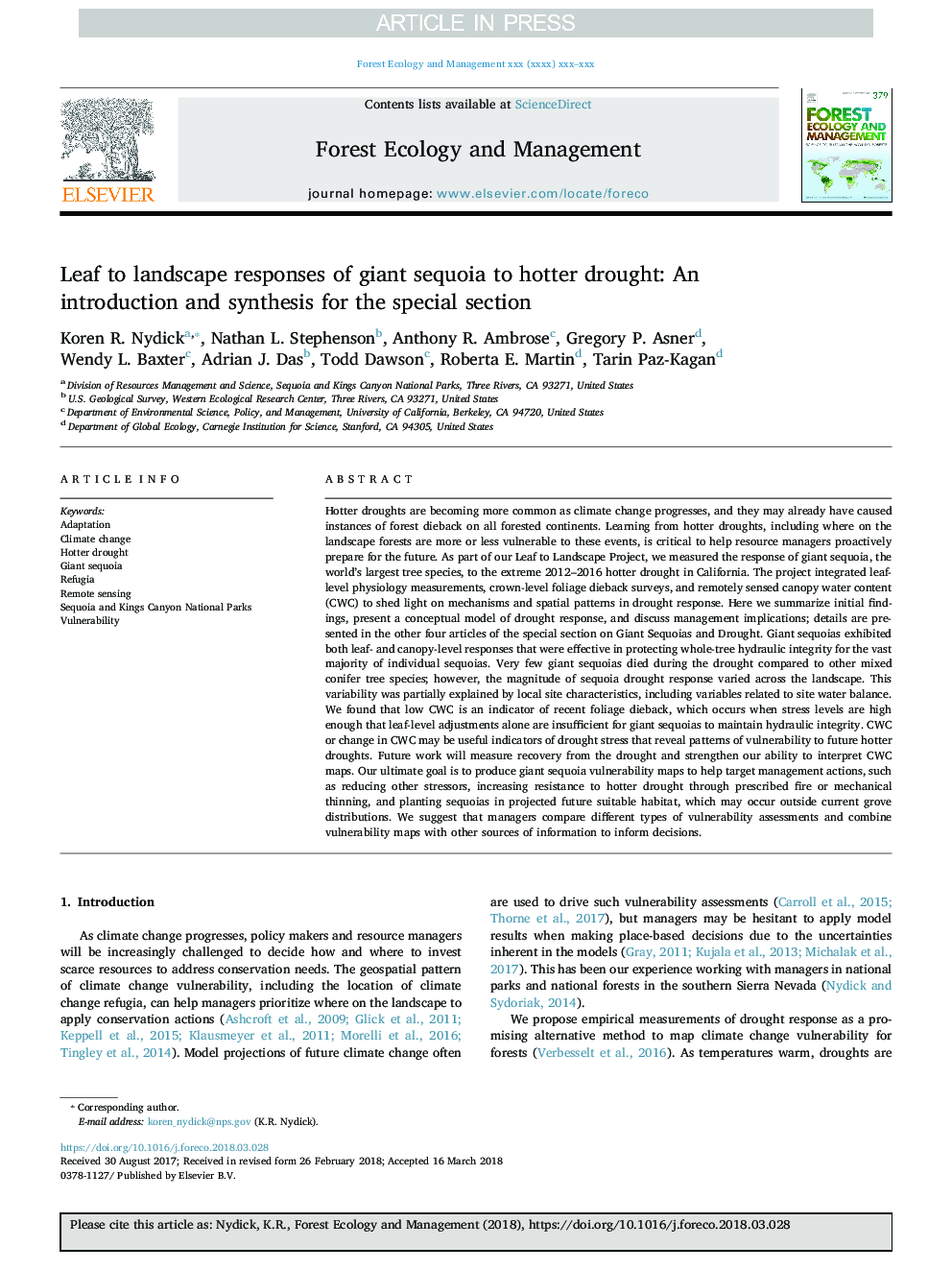| کد مقاله | کد نشریه | سال انتشار | مقاله انگلیسی | نسخه تمام متن |
|---|---|---|---|---|
| 6541694 | 1421340 | 2018 | 8 صفحه PDF | دانلود رایگان |
عنوان انگلیسی مقاله ISI
Leaf to landscape responses of giant sequoia to hotter drought: An introduction and synthesis for the special section
ترجمه فارسی عنوان
برگ به پاسخ های چشم انداز عجایب غول پیکر به خشکسالی داغ: مقدمه و سنتز برای بخش ویژه
دانلود مقاله + سفارش ترجمه
دانلود مقاله ISI انگلیسی
رایگان برای ایرانیان
کلمات کلیدی
انطباق، تغییر آب و هوا، خشکسالی داغتر، عنکبوت غول پیکر، پناهگاه سنجش از دور، پارک های ملی ساکویا و پادشاهان کانیون، آسیب پذیری،
موضوعات مرتبط
علوم زیستی و بیوفناوری
علوم کشاورزی و بیولوژیک
بوم شناسی، تکامل، رفتار و سامانه شناسی
چکیده انگلیسی
Hotter droughts are becoming more common as climate change progresses, and they may already have caused instances of forest dieback on all forested continents. Learning from hotter droughts, including where on the landscape forests are more or less vulnerable to these events, is critical to help resource managers proactively prepare for the future. As part of our Leaf to Landscape Project, we measured the response of giant sequoia, the world's largest tree species, to the extreme 2012-2016 hotter drought in California. The project integrated leaf-level physiology measurements, crown-level foliage dieback surveys, and remotely sensed canopy water content (CWC) to shed light on mechanisms and spatial patterns in drought response. Here we summarize initial findings, present a conceptual model of drought response, and discuss management implications; details are presented in the other four articles of the special section on Giant Sequoias and Drought. Giant sequoias exhibited both leaf- and canopy-level responses that were effective in protecting whole-tree hydraulic integrity for the vast majority of individual sequoias. Very few giant sequoias died during the drought compared to other mixed conifer tree species; however, the magnitude of sequoia drought response varied across the landscape. This variability was partially explained by local site characteristics, including variables related to site water balance. We found that low CWC is an indicator of recent foliage dieback, which occurs when stress levels are high enough that leaf-level adjustments alone are insufficient for giant sequoias to maintain hydraulic integrity. CWC or change in CWC may be useful indicators of drought stress that reveal patterns of vulnerability to future hotter droughts. Future work will measure recovery from the drought and strengthen our ability to interpret CWC maps. Our ultimate goal is to produce giant sequoia vulnerability maps to help target management actions, such as reducing other stressors, increasing resistance to hotter drought through prescribed fire or mechanical thinning, and planting sequoias in projected future suitable habitat, which may occur outside current grove distributions. We suggest that managers compare different types of vulnerability assessments and combine vulnerability maps with other sources of information to inform decisions.
ناشر
Database: Elsevier - ScienceDirect (ساینس دایرکت)
Journal: Forest Ecology and Management - Volumes 419â420, 1 July 2018, Pages 249-256
Journal: Forest Ecology and Management - Volumes 419â420, 1 July 2018, Pages 249-256
نویسندگان
Koren R. Nydick, Nathan L. Stephenson, Anthony R. Ambrose, Gregory P. Asner, Wendy L. Baxter, Adrian J. Das, Todd Dawson, Roberta E. Martin, Tarin Paz-Kagan,
